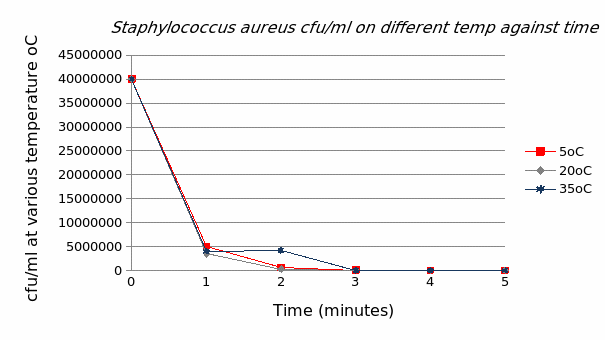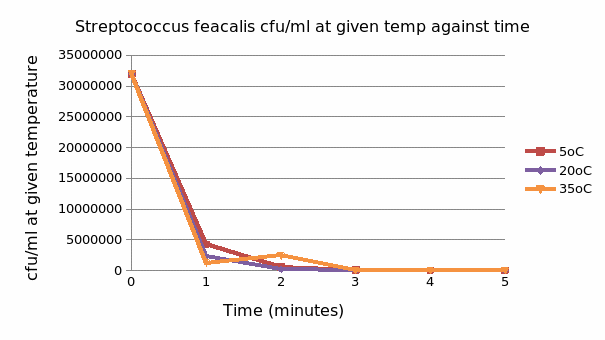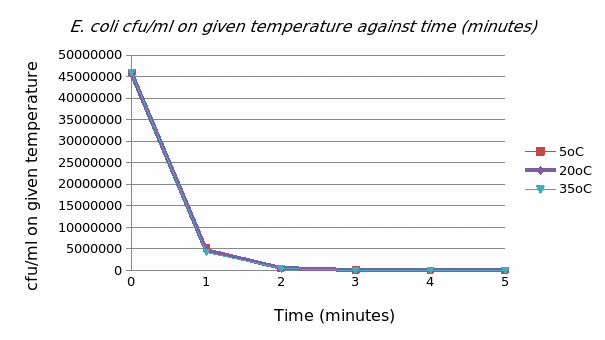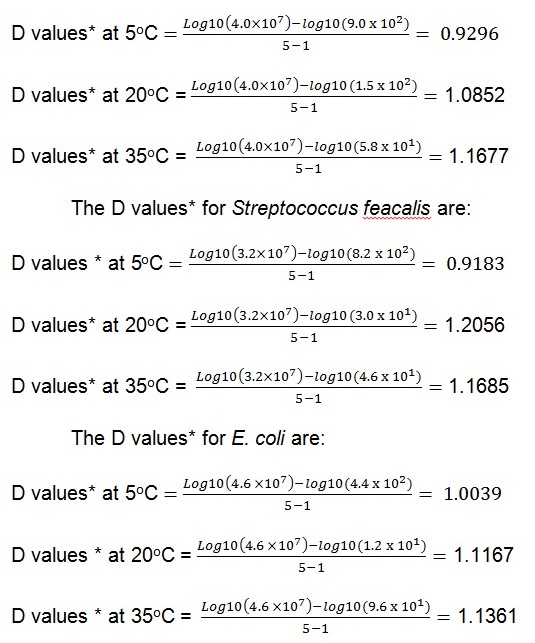Overview of thermal-chemical disinfection process
Disinfection is a process of reducing microorganisms to a level that is not harmful to health (Fraise, Lambert, & Maillard, 2003). The disinfection process can be a single step where the disinfectant is the sole means of controlling microbial growth such as contact lens solution and disinfection of household surfaces (Knight & Cooke, 2002). Also, it can be a multi-step process where chemical disinfection can be used along with mechanical or thermal disinfection such as in industry where disinfection usually follows a cleaning and rinsing step (Knight & Cooke, 2002). Thermal disinfection uses high temperatures to achieve disinfection, while chemical disinfection uses chemicals (Fraise A & Ayliffe, 2000). These two processes can be used together to achieve disinfection in a process termed as thermal-chemical disinfection (Gardner & Peel, 1998; Fraise, Lambert, & Maillard, 2003).
Plots of Inactivation curves of each vegetative bacteria
Staphylococcus aureus colony forming units decreased significantly within 1 minute at 20o C due to thermal chemical disinfection, and by firth minute, there were 150cfu/ml. At 35oC, a significant number of cfu/ml was still present, but at 20oC, the levels had declined sharply as shown in the plot for Staphylococcus aureus.
Streptococcus feacalis cfu/ml declined sharply within the first minute at 350C. However, there was growth and some multiplication within the next minute followed by inactivation in third to the fifth minute. For both 50C and 200C, the cfu/ml declines gradually to a low level from time zero to the third minute as shown in the plot.
E. coli, a common inactivation trend is observed. Although, the greatest inactivation rate was observed at 35oC.



Determination of D values* for each organism and comments
The data selected for the three vegetative bacteria is from time 0 to time 5 minutes because using logarithm to base 10, the data becomes linear, and would be more representative of the inactivation process. The units for the inactivation rate are colony forming units per ml per minute.
For Staphylococcus aureus the D values* are:

It can be concluded that for Staphylococcus aureus, the highest inactivation rate was 1.1677cfu/ml/minute at 35oC, whereas the lowest was at 5oC. The highest inactivation rate for Streptococcus feacalis was 1.2056cfu/ml/minute at 20oC and the lowest was at 5oC. The highest inactivation rate for E.coli was 1.1361cfu/ml/minute at 35oC, and the lowest rate was at 5oC.
In conclusion, as the temperature increased the rate of inactivation increased, and for Staphylococcus aureus and E.coli, 35oC was the optimum temperature for inactivation by thermal-chemical disinfection.
References
Fraise A, M. K., & Ayliffe, G. J. 2000. Control of Hospital Infection: A Practical Handbook, 4th Edition. Arnold: London.
Fraise, P. A., Lambert, & Maillard, J. Y. 2003. Principles and Practice of DIsinfection, Preservation and Sterilization, 4th edn. Blackwell Science: London.
Gardner, F. J., & Peel, M. M. 1998. Sterilization, Disinfcetion and Infection Control, 3rd Edition. Churchill Livingstone: Edinburgh.
Knight, D. J., & Cooke, M. 2002. The biocides business: regulation, safety and applications. Wiley-VCH: Weinheim.